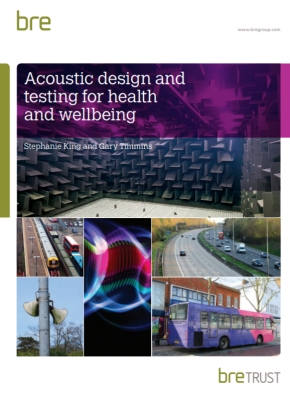Acoustic design and testing for health and wellbeing
Acoustic design and testing for health and wellbeing was written by Stephanie King and Gary Timmins and was published by the BRE Trust in February 2019. It is freely-available to download from the BRE Website.
Good acoustic conditions are fundamental to the quality and enjoyment of homes. Domestic noise problems may arise either from sound travelling from one premises to another, such as music, voices and footsteps, or from noise entering from outside, such as road and aircraft noise. The two are regulated in different ways. Sound insulation issues are dealt with through the Building Regulations. Exposure to outside noise is dealt with through the planning system. Both require careful consideration, as poor acoustic design is difficult and expensive to remedy once a building has been completed.
This 16-page guide identifies the basic elements of acoustic design and the standards most commonly used when considering noise impact on homes. It is intended to help housebuilders, building owners, designers, architects, planners, landlords and householders take the first steps towards understanding acoustic requirements for homes and the kind of technical data they might encounter on the way.
Its contents are:
- Summary.
- Introduction.
- Sources of noise disturbance – sound insulation.
- Sources of noise disturbance – environmental noise.
- The role of laboratory testing.
- Case studies.
- References.
- Acknowledgements.
[edit] Related articles on Designing Buildings
- Acoustic consultant.
- Acoustics.
- Acoustics in the workplace.
- Airborne sound.
- Approved Document E.
- Audio frequency.
- BRE articles on Designing Buildings Wiki.
- BRE Trust.
- BREEAM Acoustic performance.
- Building Bulletin 93: acoustic design of schools.
- Decibel.
- Flanking sound.
- Impact sound.
- Metamaterials.
- Noise nuisance.
- Pre-completion sound testing.
- Reverberation.
- Room acoustics.
- Sound absorption.
- Sound insulation.
- Sound insulation in dwellings: Part 1: An introduction (GG 83-1).
- Sound reduction index (SRI).
- Sound v noise.
- Structure-borne sound.
- Suitable insulation can help preserve the golden sound of silence.
- Timber and healthy interiors.
- Wellbeing.
Featured articles and news
The UK's Modern Industrial Strategy: A 10 year plan
Previous consultation criticism, current key elements and general support with some persisting reservations.
Building Safety Regulator reforms
New roles, new staff and a new fast track service pave the way for a single construction regulator.
Architectural Technologist CPDs and Communications
CIAT CPD… and how you can do it!
Cooling centres and cool spaces
Managing extreme heat in cities by directing the public to places for heat stress relief and water sources.
Winter gardens: A brief history and warm variations
Extending the season with glass in different forms and terms.
Restoring Great Yarmouth's Winter Gardens
Transforming one of the least sustainable constructions imaginable.
Construction Skills Mission Board launch sector drive
Newly formed government and industry collaboration set strategy for recruiting an additional 100,000 construction workers a year.
New Architects Code comes into effect in September 2025
ARB Architects Code of Conduct and Practice available with ongoing consultation regarding guidance.
Welsh Skills Body (Medr) launches ambitious plan
The new skills body brings together funding and regulation of tertiary education and research for the devolved nation.
Paul Gandy FCIOB announced as next CIOB President
Former Tilbury Douglas CEO takes helm.
UK Infrastructure: A 10 Year Strategy. In brief with reactions
With the National Infrastructure and Service Transformation Authority (NISTA).
Ebenezer Howard: inventor of the garden city. Book review.
The Grenfell Tower fire, eight years on
A time to pause and reflect as Dubai tower block fire reported just before anniversary.
Airtightness Topic Guide BSRIA TG 27/2025
Explaining the basics of airtightness, what it is, why it's important, when it's required and how it's carried out.
Construction contract awards hit lowest point of 2025
Plummeting for second consecutive month, intensifying concerns for housing and infrastructure goals.
Understanding Mental Health in the Built Environment 2025
Examining the state of mental health in construction, shedding light on levels of stress, anxiety and depression.























